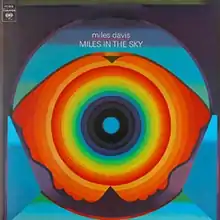| Miles in the Sky | ||||
|---|---|---|---|---|
 | ||||
| Studio album by | ||||
| Released | July 22, 1968 | |||
| Recorded | January 16 and May 15–17, 1968 | |||
| Studio | Columbia 52nd Street (New York City) | |||
| Genre | ||||
| Length | 50:56 | |||
| Label | Columbia | |||
| Producer | Teo Macero | |||
| Miles Davis chronology | ||||
| ||||
Miles in the Sky is a studio album by American trumpeter and composer Miles Davis, released on July 22, 1968, by Columbia Records.[2] It was the last full album recorded by Davis' "Second Great Quintet" and marked the beginning of his foray into jazz fusion, with Herbie Hancock playing electric piano and Ron Carter playing electric bass guitar on opening track “Stuff”. Additionally, electric guitarist George Benson features on “Paraphernalia”.[3]
Background
Miles in the Sky was produced by Teo Macero and recorded at Columbia Studio B in New York City on January 16, 1968, and May 15–17, 1968.[4] The album's title was a nod to the Beatles' 1967 song "Lucy in the Sky with Diamonds".[2] This is the final appearance of tenor saxophonist Wayne Shorter, pianist Herbie Hancock, bassist Ron Carter and drummer Tony Williams together on a full-length studio album in Davis’ discography.[4]
Composition
For Miles in the Sky, Davis and his quintet pulled further away from conventional jazz and more toward jazz-rock fusion. The album's compositions are extended and groove-oriented, often with rhythms that, according to Stephen Thomas Erlewine, "are straightforward, picking up on the direct 4/4 beats of rock, and these are illuminated by Herbie Hancock's electric piano".[3] In the opinion of All About Jazz's C. Michael Bailey, Miles in the Sky was one of six albums by Davis' quintet between 1965 and 1968 that introduced the poorly-defined jazz subgenre post-bop.[5]
Critical reception
| Review scores | |
|---|---|
| Source | Rating |
| AllMusic | |
| Down Beat | |
| The Encyclopedia of Popular Music | |
| The Penguin Guide to Jazz Recordings | |
| The Rolling Stone Album Guide | |
| Rolling Stone Jazz Record Guide | |
| Sputnikmusic | 4/5[10] |
| Tom Hull – on the Web | B+[11] |
In a contemporary review, Down Beat magazine called Miles in the Sky one of the best albums by Davis and his second quintet because of how it shows he had been influenced by Ornette Coleman and John Coltrane: "even as Miles denies it, for their assault on the popular song has pushed Miles along the only path that seems open to him, an increasingly ironic detachment from sentiment and prettiness".[4]
In a retrospective review for AllMusic, Erlewine found it less adventurous than Nefertiti (1968): "Intriguing, successful jams in many respects, but ... this is less visionary than its predecessor and feels like a transitional album – and, like many transitional albums, it's intriguing and frustrating in equal measures."[3] Hernan M. Campbell of Sputnikmusic was more enthusiastic and praised the musicianship throughout, particularly that of Williams, whose drumming he found "mind-blowing". Campbell felt that Miles in the Sky should not be overlooked because it marked the beginning of Davis' electric period and was one of the defining jazz fusion albums.[10]
Track listing
| No. | Title | Writer(s) | Recording session[13] | Length |
|---|---|---|---|---|
| 1. | "Stuff" | Miles Davis | May 17, 1968 | 17:00 |
| 2. | "Paraphernalia" | Wayne Shorter | January 16, 1968 | 12:38 |
| No. | Title | Writer(s) | Recording session[13] | Length |
|---|---|---|---|---|
| 3. | "Black Comedy" | Tony Williams | May 16, 1968 | 7:26 |
| 4. | "Country Son" | Miles Davis | May 15, 1968 | 13:52 |
| Total length: | 50:56 | |||
Personnel
- Miles Davis – trumpet, cornet on "Stuff" and "Country Son"
- Wayne Shorter – tenor saxophone
- Herbie Hancock – piano, electric piano on "Stuff"
- Ron Carter – bass, electric bass on "Stuff"
- Tony Williams – drums
- George Benson – electric guitar on "Paraphernalia"
References
- ↑ "Miles Davis's 20 greatest albums – ranked!". TheGuardian.com. August 2019.
- 1 2 "Miles Davis: Miles in the Sky". Sony Music Entertainment. Archived from the original on December 26, 2013. Retrieved December 25, 2013.
- 1 2 3 4 Erlewine, Stephen Thomas. "Miles in the Sky – Miles Davis". Allmusic. Retrieved December 25, 2013.
- 1 2 3 4 "Miles Davis – Miles in the Sky CD Album". CD Universe. Archived from the original on May 1, 2009. Retrieved December 25, 2013.
- ↑ Bailey, C. Michael (April 11, 2008). "Miles Davis, Miles Smiles, and the Invention of Post Bop". All About Jazz. Retrieved February 23, 2013.
- ↑ Larkin, Colin (2007). The Encyclopedia of Popular Music (4th ed.). Oxford University Press. ISBN 978-0195313734.
- ↑ Cook, Richard; Morton, Brian (2008). The Penguin Guide to Jazz Recordings (9th ed.). Penguin. p. 346. ISBN 978-0-141-03401-0.
- ↑ RS Album Guide
- ↑ Swenson, J., ed. (1985). The Rolling Stone Jazz Record Guide. USA: Random House/Rolling Stone. p. 58. ISBN 0-394-72643-X.
- 1 2 Campbell, Hernan M. (March 8, 2012). "Review: Miles Davis – Miles In The Sky". Sputnikmusic. Retrieved December 25, 2013.
- ↑ Hull, Tom (n.d.). "Grade List: Miles Davis". Tom Hull – on the Web. Retrieved July 22, 2020.
- ↑ "Miles Davis – Miles in the Sky". Discogs. Retrieved February 4, 2017.
- 1 2 3 "Miles Davis – Miles in the Sky". milesdavis.com. Retrieved February 4, 2017.
- ↑ "Miles Davis – Miles in the Sky (CD)". Discogs. Retrieved February 4, 2017.
External links
- Miles in the Sky at Discogs (list of releases)